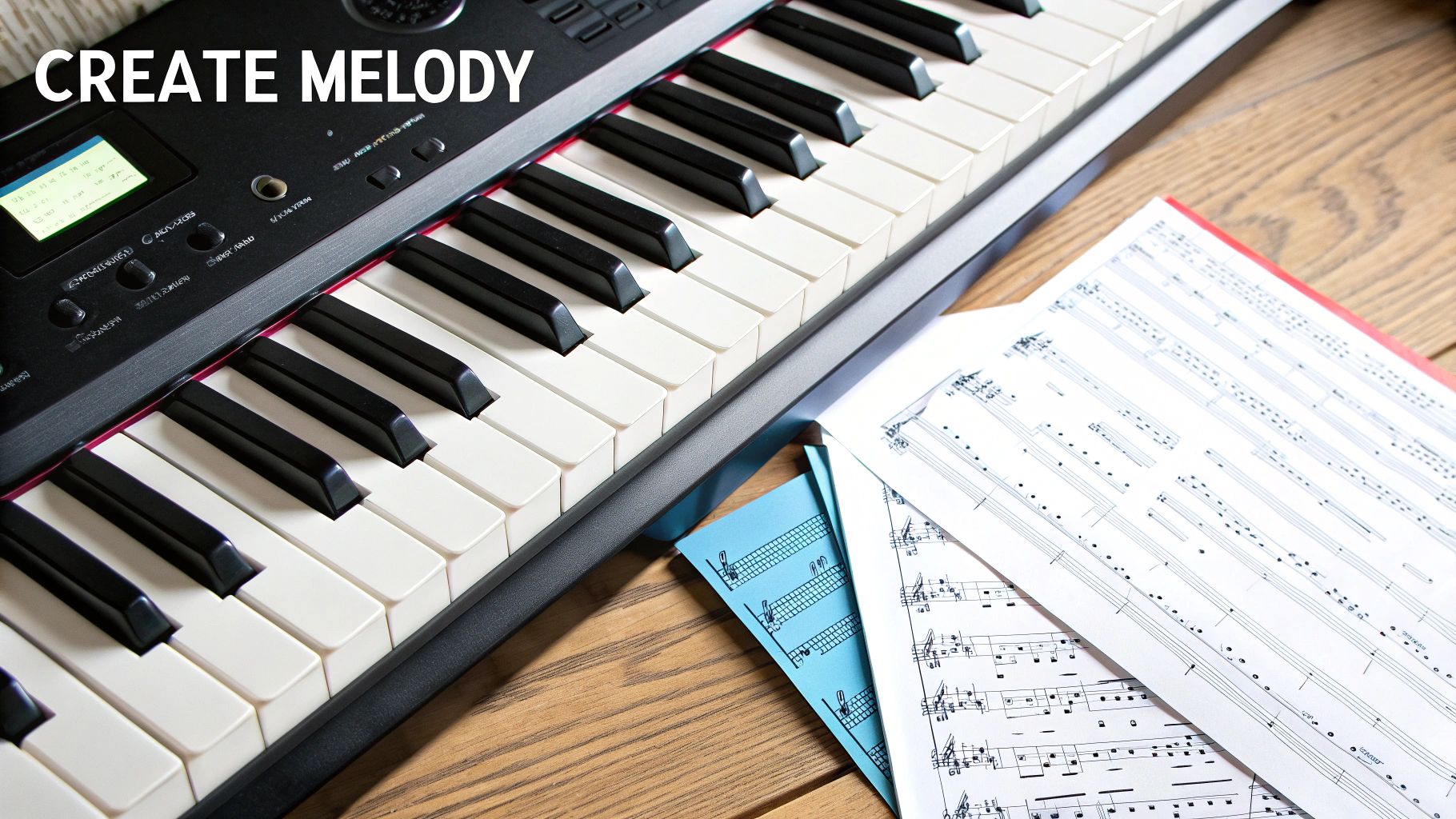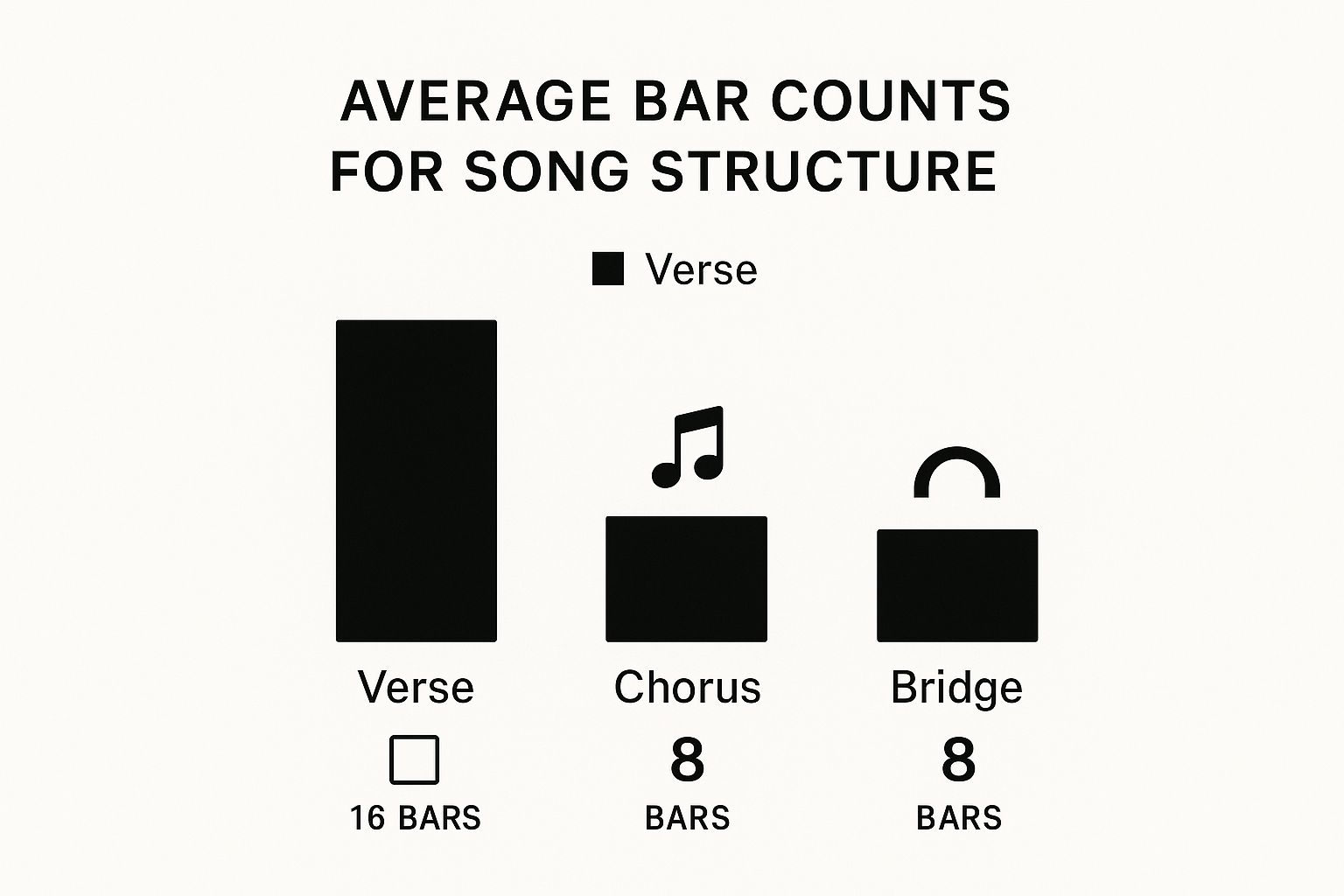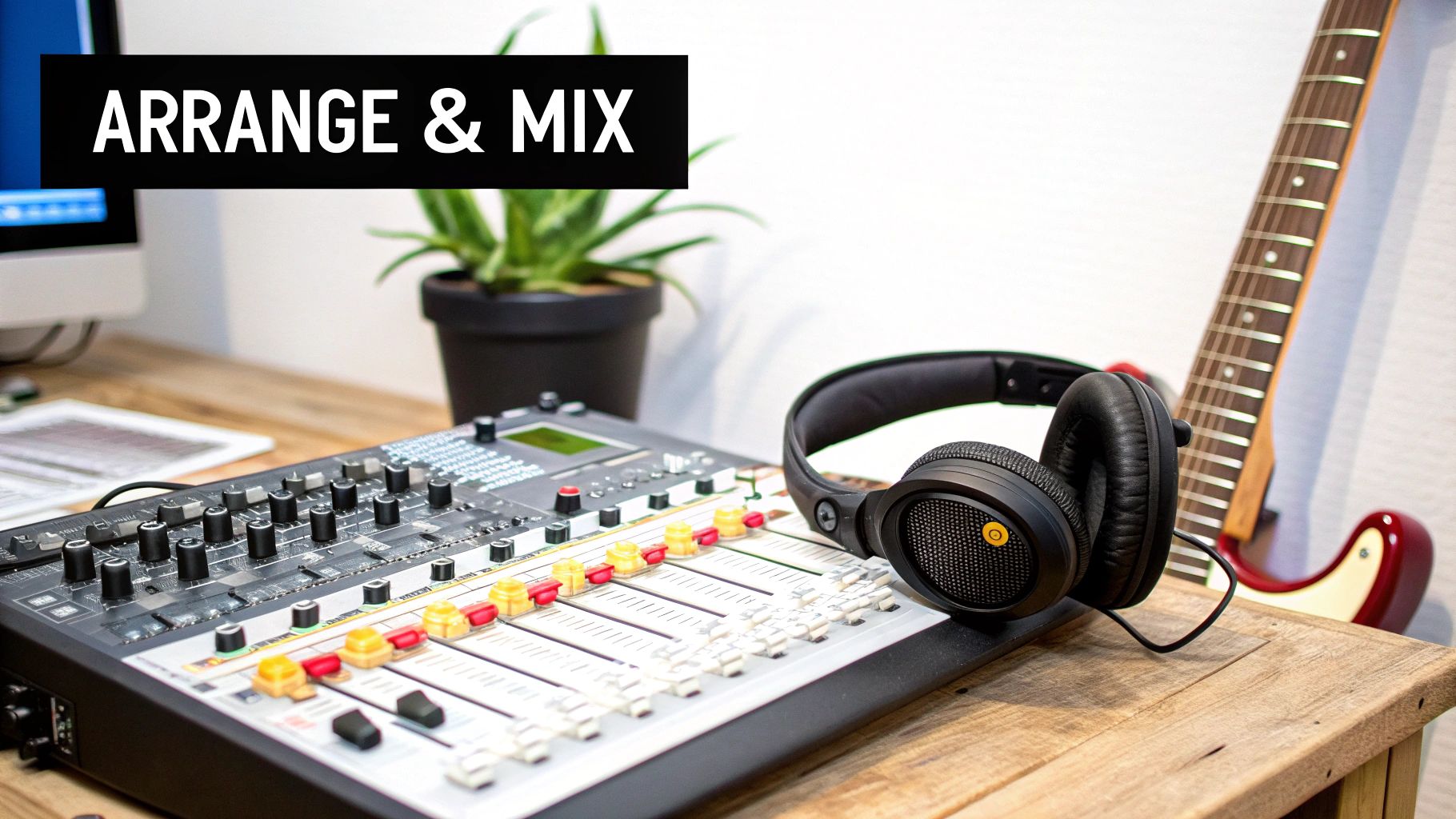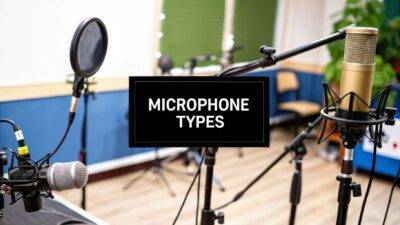Discovering Your Unique Musical Voice
Every songwriter has a different starting point. For some, a song begins as a melody hummed in the shower. For others, it's a line of dialogue from a movie that just won't leave their head. The real magic isn't in waiting for a perfect, fully-formed idea to arrive. It's about learning to recognize and trust those little creative sparks that are uniquely yours. This first part of songwriting is deeply personal—there's no right or wrong way to get started.
The trick is to always be ready to catch inspiration when it shows up. Many professional songwriters keep a running log of ideas, whether it's a physical notebook or a simple notes app on their phone. That interesting phrase you overheard at a coffee shop or that intense emotional experience you need to process? Write it down. Record a quick voice memo. These fragments are the raw materials for your future songs.
Identifying Your Creative DNA
As you start collecting these little bits of inspiration, you'll likely begin to notice patterns. Do you naturally lean toward vivid storytelling, or do you find yourself coming up with infectious melodies over simple chords? Understanding your natural strengths is a huge part of learning how to write a song step by step. Figuring out your creative DNA—your personal tendencies—helps you make confident decisions later on.
For instance, your creative strengths might fall into a few camps:
- Lyrical Storytelling: You’re great at painting pictures with words and building compelling narratives.
- Melodic Invention: You have a knack for creating catchy, memorable tunes that get stuck in people's heads.
- Rhythmic Foundation: Your ideas often kick off with a cool drum pattern or a groovy bassline.
Knowing where you naturally shine lets you lead with your strongest suit and build the rest of the song around that foundation. This isn't about neglecting the other elements, but about starting from a place of confidence.
Standing Out in a Crowded World
Developing a distinct musical voice is more important today than ever before. The music world is experiencing a flood of new songs. It's estimated that around 1 million songs are released globally each week as of 2025, and that number is projected to climb to between 3 and 5 million per week by 2030. This makes the songwriting process not just about creativity, but also about finding a way to be different.
By leaning into what makes you unique, you're not just writing another song; you're building an identity that can cut through all that noise. If you're curious, you can explore more about the future of songwriting in this high-volume music market on benjamingroff.com.
Crafting Lyrics That Connect With Real People

Once you've got that initial spark of an idea, the next logical step is turning those feelings into words. Lyrics are the soul of your song—they're what make someone stop and think, "Wow, I know exactly what that feels like." The most resonant lyrics aren't always the most complicated or poetic; they're the most honest. Genuine emotion will always hit harder than a perfectly forced rhyme.
The real trick is to go beyond just stating an emotion, like saying "I'm sad." You need to show the listener what that sadness looks like in the real world. Think about the difference between "I miss you" and describing the untouched coffee mug they left on the counter. Those specific, concrete details are what paint a picture, letting your audience step right into the story with you. This classic "show, don't tell" approach is a foundation of great songwriting.
Finding Fresh Angles on Familiar Themes
Love, heartbreak, and growing up are popular themes for a reason—they're universal. But that also means it's easy to fall into clichés. The real challenge is finding your own unique take. How do you write about a breakup without resorting to the same tired phrases everyone has already heard a million times? A great way to tackle this is to zero in on a specific, maybe even slightly weird, detail. For more ideas on this, our full guide on how to write song lyrics has a ton of practical exercises.
Finding a fresh angle can make a common topic feel completely new. To get your creative gears turning, check out this table comparing some overused themes with more engaging approaches.
| Traditional Theme | Fresh Approach | Example Technique |
|---|---|---|
| Heartbreak | Focus on a small, mundane detail that now feels enormous. | Write about the TV shows you can no longer watch because they were "your" shows together. |
| Celebration | Describe the quiet, peaceful moment after the big party ends. | Focus on the feeling of relief and calm contentment, not just the loud excitement. |
| Growing Up | Center the song around a single object from your childhood. | Use a beat-up pair of sneakers as a metaphor for your entire journey from then to now. |
By focusing on an unexpected perspective, you can make these timeless themes feel personal and original. It invites the listener into a more specific and memorable emotional space.
Making Your Lyrics Feel Conversational
Your lyrics should sound like they're being spoken by a real person, not recited from a poetry book. A simple but effective exercise is to speak your lines out loud. Do they roll off the tongue naturally? Or do they feel stiff and awkward? If a phrase sounds clunky when you say it, it's almost guaranteed to sound just as clunky when you try to sing it.
Don't shy away from using simple, everyday language. Some of the most emotionally powerful songs are built from straightforward words. The real magic happens when those simple words are combined with a compelling melody and emotional context. By prioritizing genuine feeling, vivid details, and a natural, conversational flow, you'll be on your way to writing lyrics that stick with people long after the song is over.
Creating Melodies That Stick in Your Head

Now that your lyrics are taking shape, it’s time to give them a voice. A great melody is what makes a song truly unforgettable—it’s the part people hum in the car and what gets stuck in their heads for days. But crafting a killer tune isn't some mystical art. It’s about making creative choices with pitch and rhythm that support the emotion you've already established in your lyrics.
Some songwriters start here, with a guitar riff or a piano chord progression, letting the music inspire the words. Others, like we’re doing, build the melody on top of a lyrical foundation. There’s no right or wrong approach in how to write a song step by step; what matters is finding a melody that feels inseparable from the words it carries. Don't be afraid to experiment. Hum ideas over your lyrics, record them on your phone, and see what feels natural.
Finding Your Melodic Contour
Think of your melody as a landscape with peaks and valleys. This shape, or melodic contour, is vital for creating emotional impact. A melody that jumps up to a high note in the chorus can create a feeling of release or excitement. A verse melody that stays in a lower, more conversational range can feel intimate and reflective.
The trick is to match this contour to your song's story. If your verse describes a problem and your chorus presents the hopeful solution, your melody should reflect that shift. For example, if a verse is about feeling trapped, the melody might move in small, tight steps. When the chorus hits with a message of breaking free, the melody could soar to the highest note in the song, creating a powerful emotional peak.
Using Rhythm and Repetition
It's not just the notes you choose but also their rhythm that makes a melody stick. A simple, repetitive rhythmic pattern can be incredibly catchy. Think about how many classic pop choruses use a very similar rhythm for each line—this is intentional. It makes the melody predictable and easy for listeners to latch onto.
Here’s a practical way to approach this:
- Establish a Rhythmic Hook: Try singing your chorus lyrics using just one or two simple rhythmic patterns. This can become the foundation.
- Introduce Variation: In your verses or pre-chorus, slightly alter the rhythm to build anticipation. You can hold a word out longer or add a few quicker notes to keep things interesting.
- The Singability Test: Once you have a melodic idea, sing it without any instruments. Is it easy to remember and sing back? If you struggle to recall it after a few minutes, it might be too complex. The best melodies are often deceptively simple.
Ultimately, your melody and lyrics should feel like a team, working together to tell the same story. By focusing on contour, rhythm, and singability, you move from just having words to creating a complete musical statement that connects and resonates.
Building Song Structure That Guides Listeners
You’ve got powerful lyrics and a melody that sticks. Now, it's time to build the house they'll live in. A song's structure is the blueprint for the emotional journey you're taking your listener on. When it's done right, the structure feels invisible, guiding the listener through moments of tension and release without them even noticing the framework holding it all together.
The most familiar structure by far is the classic verse-chorus format. The verses are where you tell the story and move the narrative forward, while the chorus lands the emotional knockout punch—that central idea you want echoing in your listener's mind long after the song ends. But that's just one way to build a song, and your choices here will dramatically shape how your music feels and connects.
Choosing Your Framework
The structure you pick should always serve the song's core message. While verse-chorus is popular for a reason, don't feel locked into it. Sometimes a different approach tells a better story. For example, a simple verse-verse-verse structure can be incredibly powerful for a story-driven folk song where the narrative just keeps unfolding.
Think of these structural pieces as tools in your songwriting kit:
- Pre-Chorus: This is your secret weapon for building anticipation. It's a short section that ramps up the tension right before the chorus, making the chorus's arrival feel like a huge, satisfying payoff.
- Bridge: Usually popping up after the second chorus, the bridge is your chance to change things up. You can shift the lyrical perspective, introduce a new chord progression, or just build a ton of energy before heading into the final, explosive chorus.
- Outro: This is your last chance to make an impression. You could fade out on a repeating line from the chorus, bring in a new, reflective melody, or cut everything short for a sudden, dramatic ending.
These structural choices are also shaped by the music industry itself. With the industry projected to reach $65.45 billion in 2025, mostly from digital streaming, songs are often arranged to grab and hold a listener's attention fast. You can learn more about how money is influencing modern music in this deep dive on frontmanphilosophy.com. For a practical guide on putting all these sections together, our article on how to arrange a song is a great next step.
Bringing Your Songs to Life Through Recording
You’ve got a solid structure, a memorable melody, and lyrics that mean something. You have the heart of a song. Now, it's time to give it a body. The recording process turns your musical idea into something real—a piece of audio you can share with the world. Your demo is often the first impression your song will make, so the goal isn't studio perfection. It's about capturing the core emotion and vision of your song clearly and compellingly.
This is a key part of learning how to write a song step by step, because your arrangement choices will either elevate or clutter your core message. Think of yourself as a film director, deciding which elements deserve the spotlight and which should play a supporting role. Every instrument, harmony, and even a moment of silence should serve the song’s emotional journey. Does adding that extra guitar part make the chorus feel bigger, or does it just compete with the vocal? Sometimes, the most powerful choice is simplicity.
Layering and Arrangement Strategies
When you first start recording, it's easy to get carried away and just keep adding layer after layer. A much better approach is to build your arrangement thoughtfully, making sure each new element has a clear purpose. Always start with the foundation—that’s usually your main instrument (like a guitar or piano) and your lead vocal. Getting these two parts right is essential. If you want to dive deeper into getting a great vocal take, our guide on how to record vocals at home is a fantastic resource.
Once that core is solid, you can start thinking about what else the song might need. Here are a few ideas:
- Rhythmic Support: A simple bassline that locks in with your kick drum can add a surprising amount of power and groove. Even programmed drums can feel more human if you play around with the velocity of each hit.
- Harmonic Texture: Think about adding subtle keyboard pads or a simple counter-melody from another instrument. These can fill out the sound without overpowering the main vocal.
- Vocal Layers: Doubling your lead vocal just in the chorus or adding some simple "oohs" and "aahs" can make those sections feel bigger and more impactful. Don't overdo it—a few well-placed harmonies are almost always more effective than a wall of sound.
Visualizing Your Arrangement
It can also be helpful to think about your arrangement in visual terms. The infographic below shows the typical length, in bars, for the most common sections of a song.

As you can see, verses—where the storytelling happens—are often given more space to breathe, while choruses and bridges tend to be shorter and more direct. Understanding these common lengths can help you pace your arrangement, ensuring no section overstays its welcome. Remember, the goal is to record a demo that clearly communicates your song’s potential, not a finished masterpiece. Keep it clean, focused, and emotionally honest.
Protecting Your Work and Building a Sustainable Career

Writing a song you love is an incredible feeling. But if you want to turn that passion into a career, you’ll need to get comfortable with the business side of music. It might sound daunting, but understanding the basics of copyright, publishing, and royalties is a key part of learning how to write a song step by step as a professional. Your song is your intellectual property, and just like any other valuable asset, it needs protection to create opportunities for you.
You don’t need a law degree to get started. It’s all about building good habits. From the moment you record an idea or write down lyrics, your song is technically copyrighted. However, officially registering your work with your country's copyright office gives you much stronger legal standing if you ever need to prove you're the owner.
Securing Your Creative Contributions
Collaboration is one of the best parts of making music, but it can also make ownership tricky. Before you even start a co-writing session, it's smart to have an open chat about how you’ll divide the songwriting credits. A simple split sheet is a document where all writers agree on their percentage of ownership. Getting this sorted out from day one can save you from messy and expensive disagreements later.
Your ownership percentage directly impacts how you get paid. This is where music publishing comes in—it’s the work of managing your song's copyright and making sure you collect the money you've earned. The independent music publishing sector was valued at €2.57 billion in 2023, with indie publishers now holding the largest global market share at 26.3%. That figure shows just how much financial potential is connected to your creative work. You can dive deeper into this growing market in the IMPF's latest global report.
Building Diverse Revenue Streams
Once your song is protected, you can begin to explore the different ways it can make money. Beyond simple streaming numbers, songwriters have several important income sources:
- Performance Royalties: These are generated whenever your song is played publicly—think radio, TV shows, or live concerts.
- Mechanical Royalties: You earn these every time your song is reproduced. This includes streams, digital downloads, and physical copies like CDs or vinyl records.
- Sync Licensing: This is the big one for many writers. It’s when your song gets placed in a movie, TV series, advertisement, or video game. A good sync placement can provide a major payday and fantastic exposure.
Getting a handle on these basics gives you the power to make informed decisions about your career, whether you decide to work with a publisher or manage your songs independently. It helps ensure your musical journey is not only creative and fulfilling but also financially sustainable.
Your Next Songs Are Waiting
Finishing that first song isn't the finish line; it’s the starting block for an incredibly rewarding creative journey. The real growth comes from consistently applying what you’ve learned, sharpening your unique voice, and building a catalog of your work. Every professional songwriter started exactly where you are now—with an idea worth sharing and the courage to see it through.
The key to building momentum is to keep writing. Your goal shouldn’t be to write a hit every single time, but simply to finish songs. This regular practice is what turns you from someone who wrote a song into a songwriter.
Staying Motivated and Growing
Keeping your creative energy up through the inevitable highs and lows is essential for long-term growth. One of the best ways to get better is by asking for constructive feedback. Play your new songs for trusted friends or fellow musicians. Pay attention to that moment you feel the need to say, "I'm still working on this part"—that's often your gut pointing out exactly where improvements are needed.
Additionally, learning how to write a song step by step means finding a balance between your influences and your own unique perspective.
- Study, Don't Copy: Pull apart the structures and melodies of songs you love. Use those insights to fuel your original ideas, not just to imitate what’s already been done.
- Embrace Collaboration: Working with others can bring in fresh ideas and help fill gaps in your own skillset. Don’t be afraid to co-write, even if it’s just to get another point of view on a lyric that’s giving you trouble.
- Set Realistic Goals: Try to finish one song a month, or even just a new verse each week. Small, consistent wins are much more effective for building confidence and skill than waiting around for a single burst of inspiration.
Remember, every song you finish, no matter how you feel about its quality, makes you a better writer. It strengthens your creative muscles and gets you ready for when a truly great idea strikes.
Ready to take your skills to the next level? At ChordX, we offer expert tips and in-depth resources to help you produce polished, market-ready tracks.



